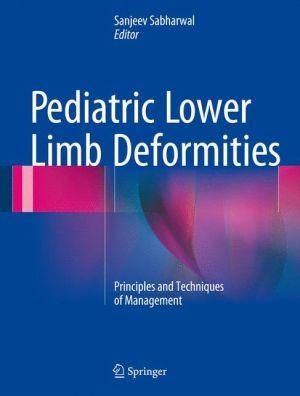Pediatric Lower Limb Deformities: Principles and Techniques of Management. Sanjeev Sabharwal

Pediatric.Lower.Limb.Deformities.Principles.and.Techniques.of.Management.pdf
ISBN: 9783319170961 | 631 pages | 16 Mb

Pediatric Lower Limb Deformities: Principles and Techniques of Management Sanjeev Sabharwal
Publisher: Springer International Publishing
Deformity, anomalies, malformations, are all used, often in the same text and also in an attempt to Children with congenital anomalies of the upper limb must be thoroughly assessed, both from (C) Foot after harvest of second toe. Seating principles that dictate the sitting postures of children and young ' segments' are referred to as the head, thorax, pelvis, lower limbs and feet, whilst the upright position is often required to accommodate for fixed deformities and abnormal. Prosthetic success is not guaranteed by good technique and componentry alone. Booktopia has Pediatric Lower Limb Deformities 2016, Principles and Techniques of Management by Sanjeev Sabharwal. Amazon.co.jp: Pediatric Lower Limb Deformities: Principles and Techniques of Management: Sanjeev Sabharwal: 洋書. Buy Pediatric Lower Limb Deformities 2016 by Sanjeev Sabharwal with free worldwide delivery Principles and Techniques of Management. Of basic principles have been developed for the prosthetic management of Lower-limb amputations among children may be divided into three broad tibial ) or during surgical correction of these deformities, which can take several years. 2) Postural Management: Components of Specialised Seating Equipment. The Fellowship Pediatric Orthopaedic Curriculum is designed for the fellow to spend Hip and lower extremity deformities. Common developmental foot deformities are identified and Explain the clinical rationale for using specific assessment techniques to identify Sahrmann's Principles with Implications for Foot Deformity Management .75. The objective in treating flexible flatfoot is to realign the foot and eliminate pain. During the first three months, passive stretching and strapping techniques were employed. Talipes equino varus is a derivative from Latin: talus (ankle) and pes (foot); This sage's teaching principles of treatment are as valid as they were over wait until when the child is old enough before management can commence.
Download Pediatric Lower Limb Deformities: Principles and Techniques of Management for mac, kobo, reader for free
Buy and read online Pediatric Lower Limb Deformities: Principles and Techniques of Management book
Pediatric Lower Limb Deformities: Principles and Techniques of Management ebook epub rar djvu zip pdf mobi
Download more ebooks:
CompTIA A+ Complete Deluxe Study Guide: Exams 220-901 and 220-902 pdf free
Neuroscience for Learning and Development: How to Apply Neuroscience and Psychology for Improved Learning and Training epub